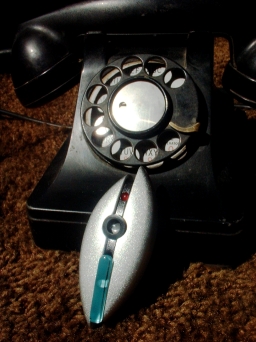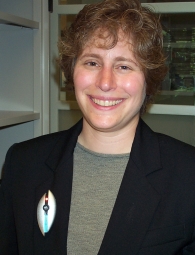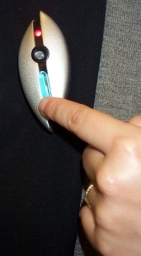 |
 |
| Fair Witness mockup with Western Electric "black phone" |
In the late '90s at Interval Research I fell to musing about video as a medium, inspired by the ground-breaking project that Paul Freiberger lead at Interval building an ur-RePlay/Tivo device, and how video might be put to new social uses other than commercial broadcast tv. Paul and I came up with a project we called the "Digital Video Brownie", aimed at making and sharing short video clips... we tried to think of video as NOT television -- the "not" (or inversion) of highly produced centrally distributed streams of visual and audio narrative content. So what is the structural inversion of television?
Television is produced by someone else than the viewer; it comes on a set schedule; it is composed of many clips; it has high production values. The means of production are expensive, and centralized.
Doing a structural inversion on these qualities lead to the idea of the short video clip, created by an individual, as a media type. And we explored that idea in the hardware design sketch we came up with for the Digital Video Brownie... basicly a Palm Pilot like device with an embedded camera and the ability to squirt clips around via infrared, aimed a tteen girls as the audience - which, sadly, did not get funded.
Well, fine. But where else could these short video clips come from? And what novel social uses might they be put to?
 |
| Sandra Carrico wearing Fair Witness mockup |
Further musings lead me to a radical simplification of the means of production of video - of the video camera. A video camera has lots of controls, enabling fancy local recording, focusing, playback, etc. It also has local storage. What I came up with is the idea of a wearable camera, rather like a Star Trek communicator pin - which would be turned on when you slap it, and turned off when you slap it second a time (this is the simplest UI I've ever designed!).
When on, it would light a red LED, so anyone present would know they are being recorded. The recording would not be stored locally, but would rather be immediately transmitted via a 2.5G or 3G cellular telephony network to a server. This transmission would be encrypted at the source, and incorporate a space-time stamp (e.g., GPS, or time of flight from three cellular towers). Once in the server, it would be possible for the creator of the video clip to cause it to be served up - but NOT to be edited or replaced - the server would be an escrow server.
There is no viewfinder in Fair Witness. There is no local playback. The lens is wide angle. The video created by fair Witness is not highly produced - it might not be very pleasant to watch, but it would be veridical. And it would be non-alterable, with a provable chain of evidence.
So what kinds of social uses could such a video device and escrow service be put to?
I thought of several intriguing uses which extend and build on existing social practices and norms:
 |
| Activating Fair Witness |
- Handshake contracts. These are legally binding - but proving them is a problem.
- Protesters & cops... I'd like to give Fair Witness to both the protesters - allowing immediate broadcast of events, with no tape or film to be confiscated - and to the police... in the hope that an outbreak of civility would occur.
- Meeting new people... at a party, or at a new job, for example. I'd love to have this for myself - I easily forget faces and names, especially when I'm someplace new and meet ten or twenty people. I would use it to record all people I get introduced to at a convention - and then review the faces and names in the evening at the hotel, and put the clips into a digital "Farley file" of personal contacts.
- Settling "he-said-she-said" arguments... imagine wearing Fair Witness, and turning it on at the start of a domestic difficulty. It would allow "rewinding" an argument. I find myself wondering if this would increase or decrease the rates of divorce.
When I joined AT&T Labs in 2000 I found a receptive audience for the idea of Fair Witness, since I pointed out that this device would create large amounts of data to be shipped about on the AT&T backbone network, and on the nascent AT&T Wireless 2.5G/3G cellular networks. I pitched it as a razor handle that could be given away, to enable AT&T to sell lots of razor blades in the form of the services that would be enabled.
I hired Studio Red, of Redwood City, California to do the concept drawings and mockups. I simultaneously started a systems design, to build the device.
I soon discovered that sufficient compact computer power for implementing Fair Witness did not exist as a buyable system, so I proposed the creation of a very powerful very compact wearable computer system as a prototyping tool for exploring networked rich media services. This became the "Kava Project", for which I was the system architect. Kava was delivered in December 2001 as a Palm III sized wearable Linux computer using a 700Mz Intel XScale processor, a dual CPU AMD DSP, 250M RAM, and 500M Flash, with CD quality digital audio IO, and with 802.11, ethernet, and V90 on daughter cards. It was an Open Source hardware and software platform - the first Open Source project approved by AT&T's legal department.
Kava became "shelfware" as soon as it was delivered, because AT&T Labs announced massive layoffs, and our entire group was laid off. Fair Witness died as well...
...but I'd love to take the idea somewhere else, and build it out!"Farley File":
One of Franklin Delano Roosevelt's most powerful political weapons, dating from his days as governor of New York, was the "Farley File". James Aloysius Farley was Roosevelt's campaign manager, and later chairman of the Democratic National Committee. Farley kept a file on everyone who ever met Roosevelt. Whenever anyone was scheduled to meet again with Roosevelt Roosevelt would review their file, allowing him to meet them again knowing their spouse, their children's names and ages - anything which had come out of earlier meetings, and any other intelligence Farley added to to file. The effect was powerful, and intimate.